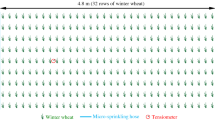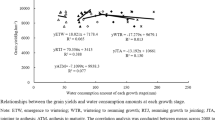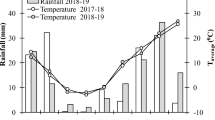Abstract
A 3-year field experiment was conducted to evaluate the applicability of drip irrigation, winter wheat growth and water use under different drip irrigation regimes in the North China Plain (NCP) during 2014–2017. Five irrigation regimes with the soil matric potential (SMP) thresholds at 20 cm depth immediately under the emitters were − 10, − 20, − 30, − 40 and − 50 kPa. The results showed that scheduling drip irrigation with SMP thresholds at 20 cm depth obviously affected the soil moisture status in the root zone, and the lower the SMP threshold was, the lower the average soil moisture content was. Soil moisture consumption of winter wheat occurred mainly in 0–60 cm soil layer in anthesis stage, and reached a depth of 80 cm in grain filling stage, and there was no deep percolation but groundwater recharge in 130 cm layer. SMP thresholds had significant effects on grain yield and water use efficiency (WUE), and there was a tendency for the two indicators to reach their highest values when the SMP threshold was around − 40 kPa in the normal years. Both yield and WUE decreased with the decrease of SMP in the dry year. Winter wheat evapotranspiration and irrigation amount decreased by 0.12% and 0.92%, respectively, and the irrigation water use efficiency increased by 1.22% with each unit of SMP decrease. Compared with the average grain yield, irrigation amount and WUE under local surface irrigation management, drip irrigation with the SMP threshold of − 40 kPa resulted in a yield increase of 4.3%, water savings of 46.6%, and WUE increase of 10.5%. The yield increase wasn’t significant to attract farmers to adopt drip irrigation technology, but the water saving was obvious. So, in the NCP, if the investment of drip irrigation system was likely to be government subsidized, it was recommended to drip irrigate winter wheat with the SMP threshold of − 40 kPa at 20 cm depth immediately under the emitters.











Similar content being viewed by others
Change history
23 May 2020
In the original article, the article title has been published incorrectly. The correct title is ���Winter wheat growth and water use under different drip irrigation regimes in the North China Plain���
References
Abrisqueta JM, Ruiz A, Franco JA (2001) Water balance of apricot trees (Prunus armeniaca L. cv. Bulida) under drip irrigation. Agric Water Manag 50:211–227. https://doi.org/10.1016/s0378-3774(01)00086-5
Bar-Yosef B (1999) Advances in fertigation. Adv Agron 65:1–77. https://doi.org/10.1016/s0065-2113(08)60910-4
Cheng YW, Ren H, Ma FY et al (2011) Characteristics of accumulation, allocation and transaction of dry matter in spring wheat under drip irrigation in northern Xinjiang. J Shihezi Univ 29:133–139. https://doi.org/10.13880/j.cnki.65-1174/n.2011.02.024
Clark GA, Albregts EE, Stanley CD et al (1996) Water requirements and crop coefficients of drip-irrigated strawberry plants. Trans ASAE 39:905–913
Dagdelen N, Basal H, Yilmaz E et al (2009) Different drip irrigation regimes affect cotton yield, water use efficiency and fiber quality in western Turkey. Agric Water Manag 96:111–120. https://doi.org/10.1016/j.agwat.2008.07.003
Fang Q, Zhang XY, Shao LW et al (2018) Assessing the performance of different irrigation systems on winter wheat under limited water supply. Agric Water Manag 196:133–143. https://doi.org/10.1016/j.agwat.2017.11.005
Feng W, Zhong M, Lemoine JM et al (2013) Evaluation of groundwater depletion in North China using the Gravity Recovery and Climate Experiment (GRACE) data and ground-based measurements. Water Resour Res 49:2110–2118. https://doi.org/10.1002/wrcr.20192
Hlavacova M, Klem K, Rapantova B et al (2018) Interactive effects of high temperature and drought stress during stem elongation, anthesis and early grain filling on the yield formation and photosynthesis of winter wheat. Field Crops Res 221:182–195. https://doi.org/10.1016/j.fcr.2018.02.022
Hodnett MG, Bell JP, Koon PDA et al (1990) The control of drip irrigation of sugarcane using index tensiometers-some comparisons with control by the water-budget method. Agric Water Manag 17:189–207. https://doi.org/10.1016/0378-3774(90)90065-7
Kang YH (2004) Applied method for drip Irrigation scheduling. Water Saving Irrig 3:11–15
Kang SZ, Li YJ (1997) Tendency and countermeasure of 21st century water-saving agriculture development in China. Trans CSAE 13:1–1
Kang YH, Wan SQ (2005) Effect of soil water potential on radish (Raphanus sativus L.) growth and water use under drip irrigation. Sci Horticult 106:275–292. https://doi.org/10.1016/j.scienta.2005.03.012
Kang SZ, Zhang L, Liang YL et al (2002) Effects of limited irrigation on yield and water use efficiency of winter wheat in the Loess Plateau of China. Agric Water Manag 55:203–216. https://doi.org/10.1016/s0378-3774(01)00180-9
Kang YH, Wang FX, Liu HJ et al (2004) Potato evapotranspiration and yield under different drip irrigation regimes. Irrig Sci 23:133–143. https://doi.org/10.1007/s00271-004-0101-2
Liu CM, Yu JJ, Kendy E (2001) Groundwater exploitation and its impact on the environment in the North China Plain. Water Int 26:265–272
Liu CM, Zhang XY, Zhang YQ (2002) Determination of daily evaporation and evapotranspiration of winter wheat and maize by large-scale weighing lysimeter and micro-lysimeter. Agric For Meteorol 111:109–120. https://doi.org/10.1016/s0168-1923(02)00015-1
Liu EK, Mei XR, Yan CR et al (2016) Effects of water stress on photosynthetic characteristics, dry matter translocation and WUE in two winter wheat genotypes. Agric Water Manag 167:75–85. https://doi.org/10.1016/j.agwat.2015.12.026
Lobell DB, Ortiz-Monasterio JI (2006) Evaluating strategies for improved water use in spring wheat with CERES. Agric Water Manag 84:249–258. https://doi.org/10.1016/j.agwat.2006.02.007
Lv GH, Kang YH, Li L et al (2010) Effect of irrigation methods on root development and profile soil water uptake in winter wheat. Irrig Sci 28:387–398. https://doi.org/10.1007/s00271-009-0200-1
Mostafa H, El-Nady R, Awad M et al (2018) Drip irrigation management for wheat under clay soil in arid conditions. Ecol Eng 121:35–43. https://doi.org/10.1016/j.ecoleng.2017.09.003
Nakayama FS, Bucks DA (1986) Trickle Irrigation for Crop Production: Design, Operation, and Management. Elsevier Science Publisher, Netherlands
National Bureau of Statistics of China (2017) China statistical yearbook. China Statistics Press, Beijing
Phene CJ, Allee CP, Pierro JD (1989) Soil matric potential sensor measurements in real-time irrigation scheduling. Agric Water Manag 16:173–185. https://doi.org/10.1016/0378-3774(89)90001-2
Rasse DP, Smucker AJM (1998) Root recolonization of previous root channels in corn and alfalfa rotations. Plant Soil 204:203–212. https://doi.org/10.1023/a:1004343122448
Shah NH, Paulsen GM (2003) Interaction of drought and high temperature on photosynthesis and grain-filling of wheat. Plant Soil 257:219–226. https://doi.org/10.1023/a:1026237816578
Shao XH, Yu SE, Jiang CL et al (1996) Effect of soil matric potential on winter wheat dry matter accumulation, mineral nutrition and yield. J Hohai Univ 24:44–44
Shi Y, Lin Q, Wei DB et al (1997) Effect of soil water stress on law of water consumption and yield in winter wheat. Acta Agric Boreali Sin 12:76–76
Shock CC, Feibert EBG, Saunders LD (2000) Irrigation criteria for drip-irrigated onions. HortScience 35:63–66
Soccol OJ, Ullmann MN, Frizzone JA (2002) Performance analysis of a trickle irrigation subunit installed in an apple orchard. Braz Arch Bio Technol 45:525–530. https://doi.org/10.1590/s1516-89132002000600017
Sun HY, Liu CM, Zhang XY et al (2006) Effects of irrigation on water balance, yield and WUE of winter wheat in the North China Plain. Agric Water Manag 85:211–218. https://doi.org/10.1016/j.agwat.2006.04.008
Sun HY, Shen YJ, Yu QA et al (2010) Effect of precipitation change on water balance and WUE of the winter wheat-summer maize rotation in the North China Plain. Agric Water Manag 97:1139–1145. https://doi.org/10.1016/j.agwat.2009.06.004
Taylor SA, Ashcroft GL (1972) Physical edaphology. The physics of irrigated and nonirrigated soils. WH Freeman and Company, San Francisco
United States Department of Agriculture, Natural Resources Conservation Service. 1998. Keys to Soil Taxonomy, 8th edition. Soil Survey Staff
Wang HX, Zhang L, Dawes WR et al (2001) Improving water use efficiency of irrigated crops in the North China Plain-measurements and modelling. Agric Water Manag 48:151–167. https://doi.org/10.1016/s0378-3774(00)00118-9
Wang ZM, Wang P, Lan LW et al (2003) A water-saving and high-yielding cultivation system for bread wheat in Huang-Huai-Hai area of China. Chin Agric Sci Bull 22:25–43
Wang FX, Kang YH, Liu SP et al (2007) Effects of soil matric potential on potato growth under drip irrigation in the North China Plain. Agric Water Manag 88:34–42. https://doi.org/10.1016/j.agwat.2006.08.006
Wang FX, Wu XX, Shock CC et al (2011) Effects of drip irrigation regimes on potato tuber yield and quality under plastic mulch in arid Northwestern China. Field Crops Res 122:78–84. https://doi.org/10.1016/j.fcr.2011.02.009
Wanjura DF, Upchurch DR, Mahan JR et al (2002) Cotton yield and applied water relationships under drip irrigation. Agric Water Manag 55:217–237. https://doi.org/10.1016/s0378-3774(01)00175-5
Wu Y, Wang HZ, Yang XW et al (2017) Soil water effect on root activity, root weight density, and grain yield in winter wheat. Crop Sci 57:437–443. https://doi.org/10.2135/cropsci2015.11.0704
Xu CL, Tao HB, Tian BJ et al (2016) Limited-irrigation improves water use efficiency and soil reservoir capacity through regulating root and canopy growth of winter wheat. Field Crops Res 196:268–275. https://doi.org/10.1016/j.fcr.2016.07.009
Yohannes F, Tadesse T (1998) Effect of drip and furrow irrigation and plant spacing on yield of tomato at Dire Dawa, Ethiopia. Agric Water Manag 35:201–207. https://doi.org/10.1016/s0378-3774(97)00039-5
Zhang XY, Pei D, You MZ (2000) Response of leaf water potential, photosynthesis and stomatal conductance to varying soil moisture in four crops: winter wheat, corn, sorghum and millet. Chin J Plant Ecol 24:280–280
Zhang XY, Pei D, Hu CS (2003) Conserving groundwater for irrigation in the North China Plain. Irrig Sci 21:159–166. https://doi.org/10.1007/s00271-002-0059-x
Zhang XY, Liu XJ, Chen SY et al (2016) Efficient utilization of various water sources in farmlands in the low plain nearby Bohai Sea. Chin J Eco Agric 24:995–1004. https://doi.org/10.13930/j.cnki.cjea.160162
Zhang XY, Qin WL, Chen SY et al (2017) Responses of yield and WUE of winter wheat to water stress during the past three decades-A case study in the North China Plain. Agric Water Manag 179:47–54. https://doi.org/10.1016/j.agwat.2016.05.004
Zhang MM, Dong BD, Qiao YZ et al (2018) Effects of sub-soil plastic film mulch on soil water and salt content and water utilization by winter wheat under different soil salinities. Field Crops Res 225:130–140. https://doi.org/10.1016/j.fcr.2018.06.010
Zheng Z, Cai HJ, Hoogenboom G et al (2016) Limited irrigation for improving water use efficiency of winter wheat in the Guanzhong plain of Northwest China. Trans ASABE 59:1841–1852. https://doi.org/10.13031/trans.59.11810
Acknowledgements
This study was supported by the National Key Research and Development Program of China (Grant Nos. 2016YFC0400105, 2013BAD05B02 and 2013BAD05B08).
Author information
Authors and Affiliations
Corresponding author
Ethics declarations
Conflicts of interest
The authors declare that they have no conflicts of interest.
Additional information
Publisher's Note
Springer Nature remains neutral with regard to jurisdictional claims in published maps and institutional affiliations.
Rights and permissions
About this article
Cite this article
Bai, S., Kang, Y. & Wan, S. Winter wheat growth and water use under different drip irrigation regimes in the North China PlainWinter wheat growth and water use under different drip irrigation regimes in the North China Plain. Irrig Sci 38, 321–335 (2020). https://doi.org/10.1007/s00271-020-00673-4
Received:
Accepted:
Published:
Issue Date:
DOI: https://doi.org/10.1007/s00271-020-00673-4




